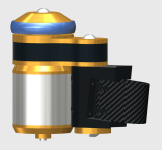cozy35
10 W
- Joined
- Oct 23, 2013
- Messages
- 71
This thread is really very interesting and right up my ally. I am working on the mechanics of a dual motor friction drive that will run off the rim brake surface in symmetrical fashion. They will be mounted to the seat stays on both sides.I have tested a basic design and it seems pretty smooth and does not have the inherent noise from running on the tire as other friction drives do. I would like to proceed to an Arduino based controller such as in this thread, but with the addition of a PAS to conform to the EU regulations. I am no programmer and would rather leave that part up to people who know better if anyone is interested. i will share the mechanical stuff in exchange. for code.
I will now use a planetary gear set to increase the torque and let the motor operate at its full speed potential.
The wheel is cast from 60A shore polyurethane rubber and is very tough and provides a good grip in the rim. At 25 Km/H and a 2.7% incline the Motor RPM = 11700 and the output of the 3:1 planetary gear-set is 2950 RPM Motor torque demand is 0.20 NM and the output of the gear-set is 0.65 NM. 250 Watts required. This is then non assisted. (Friction drive only)
Battery Voltage in the order of 22.2 V in Li-ion format.
The motors are capable of 1800 Watts between the two of them. (900 watts each) so non assisted inclines of 11% is possible at 750 watts, still well within the capability of the two motors for off-road mode.
The advantages of driving off the wheel rim makes the use of various tire types possible.
Here is a screen shot of the drive

Let me know your thoughts.
Thanks.
I will now use a planetary gear set to increase the torque and let the motor operate at its full speed potential.
The wheel is cast from 60A shore polyurethane rubber and is very tough and provides a good grip in the rim. At 25 Km/H and a 2.7% incline the Motor RPM = 11700 and the output of the 3:1 planetary gear-set is 2950 RPM Motor torque demand is 0.20 NM and the output of the gear-set is 0.65 NM. 250 Watts required. This is then non assisted. (Friction drive only)
Battery Voltage in the order of 22.2 V in Li-ion format.
The motors are capable of 1800 Watts between the two of them. (900 watts each) so non assisted inclines of 11% is possible at 750 watts, still well within the capability of the two motors for off-road mode.
The advantages of driving off the wheel rim makes the use of various tire types possible.
Here is a screen shot of the drive

Let me know your thoughts.
Thanks.


